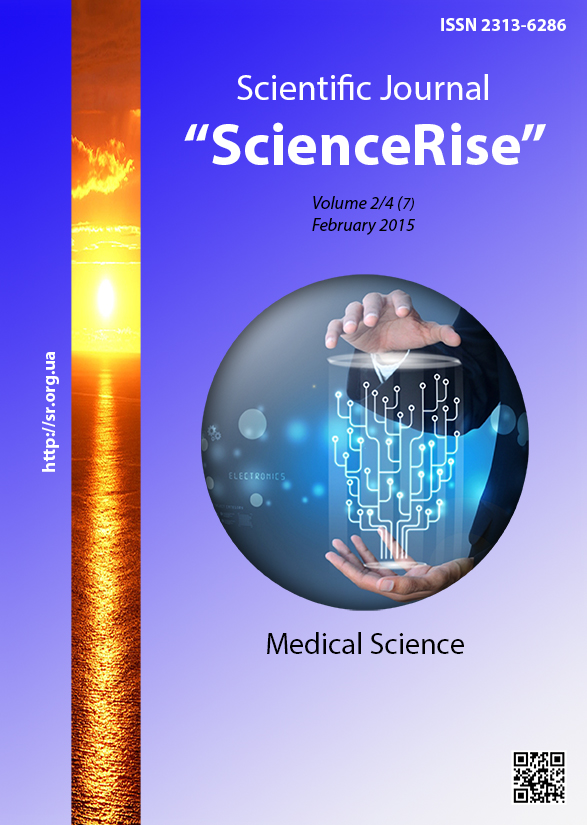Metabolic role of connective tissue in the development of pathological processes of different intensity in the stomach
DOI:
https://doi.org/10.15587/2313-8416.2015.37581Keywords:
connective tissue metabolism, degradation, biosynthesis of collagen, hydroxyproline, the stomach, the severity of the pathological processAbstract
Aim: To study changes in exchange of connective tissue at development of pathological process in a stomach.
Methods: Patients with inflammatory processes in a stomach of various severity and cancer patients were examined. Groups were created so that weight of pathological process in a stomach and risks for health increased from group to group. 5 groups on 50 people were surveyed. In each of groups the CEA level, and the level of various fractions of hydroxyproline was defined.
Results: It was revealed that the CEA levels, free- and peptide-bound hydroxyproline levels were more in groups with higher severity of pathological process. But the levels of the protein-bound hydroxyproline were less in the same groups. It is possible to assume that it is connected with growth of extent of degradation of CT in process of increase of severity of pathological process. Increasing the severity of the pathological process above a certain level causes disbalance in system of CT. It can reflect failure of adaptation in system of CT, and may be one of factors of irreversibility (chronization) of pathological process.
Conclusion: The connective tissue is essentially involved in pathological processes in a stomach. At a superficial inflammation processes of synthesis and degradation of collagen are in some balance, and the increase in severity of pathological process leads to violation of this balance
References
Quaglino, D., Boraldi, F., Annovi, G. et al. (2009). Connective tissue and diseases: from morphology to proteomics towards the development of new therapeutic approaches. Gastroenterology and Hepatology From Bed to Bench, 2, 56–65. [in English]
Sologub, T. V., Romantsov, M. G., Kremen, I. V. et al. (2008). Free-radical processes and inflammation (pathogenic, clinical and therapeutic aspects): a textbook. Moscow: The Academy of Natural History, 95. [in Russian]
Schultz, G. S., Ladwig, G., Wysocki, A. (2005). Extracellular matrix: review of its roles in acute and chronic wounds World Wide Wounds. Available at: http://www.worldwidewounds.com/2005/august/Schultz/Extrace-Matric-Acute-Chronic-Wounds.html [in English]
Potapova, V. B., Gudkova, R. B., Sokolova, G. N. (2004). Features of the connective tissue of the gastric mucosa at protractedly not cicatrized ulcer. Experimental and clinical gastroenterology, 1, 24–26. [in Russian]
Moskalev, A. V., Rudoj, A. S. (2006). Exchange cytokines and serum free hydroxyproline in patients with erosive and ulcerative diseases gastroduodenal area with undifferentiated connective tissue dysplasia. Bulletin of the Russian Military Medical Academy, 2 (16), 64–68. [in Russian]
Meunier, P. J. (1998). Osteoporosis: diagnosis and management. London: CRC Press, 304. [in English]
Marshall, W. J., Bangert, S. K. (2008). Clinical Biochemistry: Metabolic and Clinical Aspects. Edinburgh: Elsevier Health Sciences, 986. [in English]
Korepanov, A. M., Shklyaev, A. E., Sharaev, P. N. (2005). Features collagen metabolism with duodenal ulcer. Clinical laboratory diagnostics, 5, 14–16. [in Russian]
Komleva, E. O. (2012). Serum CA 15-3 and analytical support for clinical diagnostic decisions in breast cancer. Laboratory, 4, 23–24. [in Russian]
Fletcher, R. H. (1986). Carcinoembryonic antigen. Ann Intern Med, 104 (1), 66–73. doi: 10.7326/0003-4819-104-1-66 [in English].
Greenstein, A. J., Panvelliwalla, D. K., Katz, L. B. et al. (1982). Tissue carcinoembryonic antigen, dysplasia, and disease duration in colonic inflammatory bowel disease Am J Gastroenterol, 77 (4), 212–215. [in English]
Sharaev, P. N. (1990). Method for determination of free and bound hydroxyproline in serum. Laboratory work, 5, 283–285. [in Russian]
Downloads
Published
Issue
Section
License
Copyright (c) 2015 Сергей Борисович Павлов

This work is licensed under a Creative Commons Attribution 4.0 International License.
Our journal abides by the Creative Commons CC BY copyright rights and permissions for open access journals.
Authors, who are published in this journal, agree to the following conditions:
1. The authors reserve the right to authorship of the work and pass the first publication right of this work to the journal under the terms of a Creative Commons CC BY, which allows others to freely distribute the published research with the obligatory reference to the authors of the original work and the first publication of the work in this journal.
2. The authors have the right to conclude separate supplement agreements that relate to non-exclusive work distribution in the form in which it has been published by the journal (for example, to upload the work to the online storage of the journal or publish it as part of a monograph), provided that the reference to the first publication of the work in this journal is included.

